- October 20, 2023
Glass Catfish: Care Guide, Tank Setup & Info
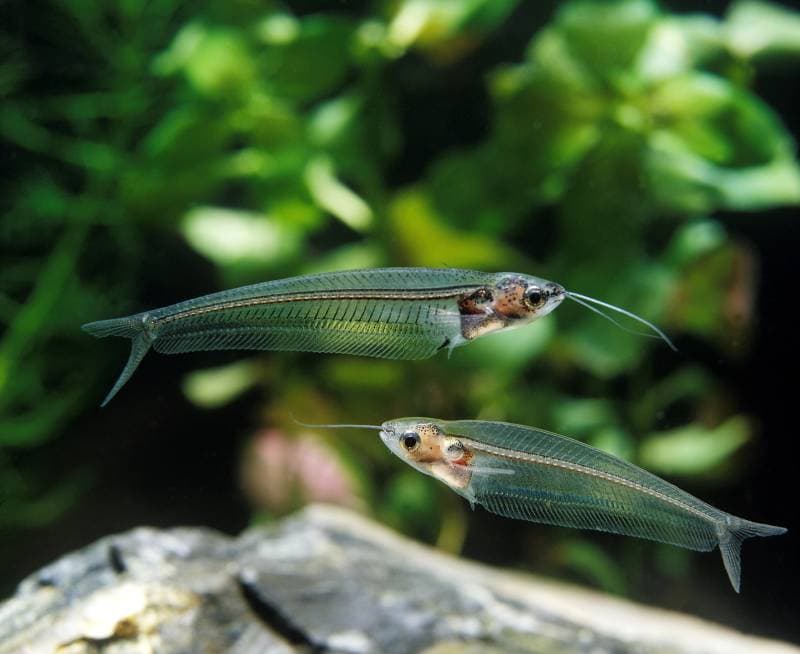
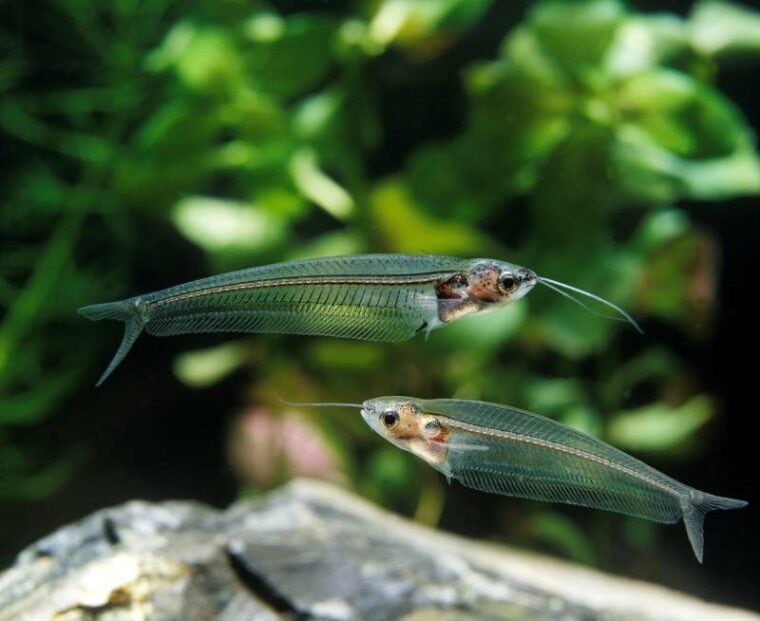
The name “Glass Catfish” refers to species of transparent freshwater fish in the Kryptopterus genus. They go by other names such as Phantom or Ghost catfish depending on the species. Glass Catfish are easily recognized by their transparent bodies that often show their skeleton and internal organs. Although Glass Catfish lack color, many fishkeepers are drawn to their unique appearance and peaceful temperaments.
Breed Overview
| Size: | Up to 3 inches long |
| Lifespan: | 5–8 years |
| Similar Breeds: | Glass bloodfin tetra, X-ray Pristella, Siamese glassfish |
| Suitable for: | Intermediate to experienced fishkeepers |
| Temperament: | Timid, social, and peaceful |
The main species of Glass Catfish in the aquarium trade industry is the K. vitreolus, which we will be referring to throughout the article. Other species such as the K. minor, K. piperatus, and K. bicirrhis can be found in aquariums too. However, they are considered rarer and sometimes confused for the same species.
Glass Catfish not only have confusing taxonomic rankings, but challenging care requirements. They are sensitive to water conditions and good water quality is crucial for their survival in aquariums. Glass Catfish are not forgiving of beginner fishkeeper mistakes, which makes them a better choice for more experienced fishkeepers.
Glass Catfish Characteristics

Glass Catfish Cost?
Glass Catfish originate from Thailand in Southeast Asia. They are found in murky and slow-moving coastal river basins in the Cardamom Mountains and Peninsular Thailand. The K. vitreolus species have been in the aquarium trade for decades, although they were previously mislabeled as K. bicirrhis until 2013.
It is believed that K. bicirrhis is rarely found in the aquarium trade and was possibly only found in small numbers. The K. vitreolus can be found for sale around the world although they are not as common as tetras, goldfish, and many other tropical fish. However, Glass Catfish can be found for sale in pet stores and from online retailers.
They typically cost between $10 to $30, and you will need to buy more than five at a time. Glass Catfish are social and need to be kept in groups. You can expect to spend around $30 to $70 for a group of Glass Catfish.
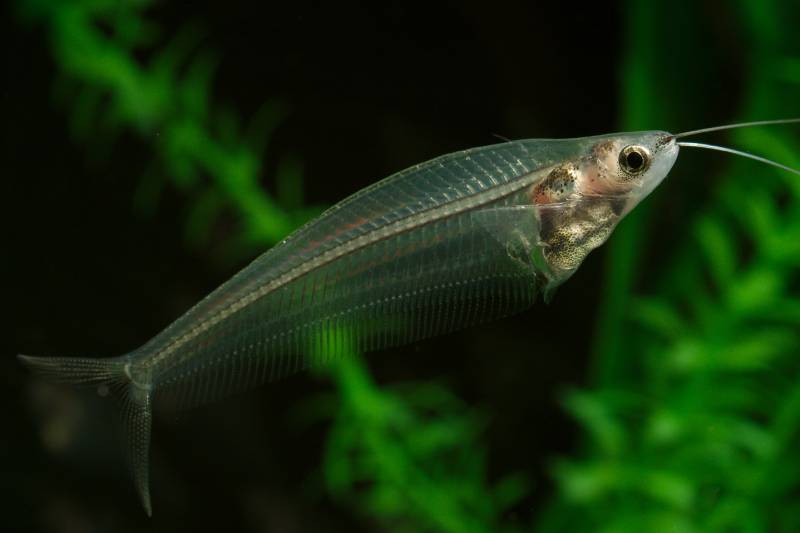
Sociability of the Glass Catfish
Do These Fish Make Good Pets?
Glass Catfish can be good pets for fishkeepers who have experience and knowledge of aquarium maintenance. This is because Glass Catfish are sensitive fish that should only be kept in mature aquariums. Even the slightest traces of ammonia and nitrite can be detrimental to Glass Catfish and stress them out. One of the most challenging parts of caring for Glass Catfish is keeping them alive long enough to reach at least 5 years old.
Glass Catfish cannot thrive in aquariums with frequent temperature fluctuations, ammonia spikes, or incompatible tank mates. They require a fully cycled aquarium and a well-filtered and oxygenated environment. You will need to run a heater in their aquarium alongside a thermometer to keep the temperature within an ideal range (75° to 82° Fahrenheit).
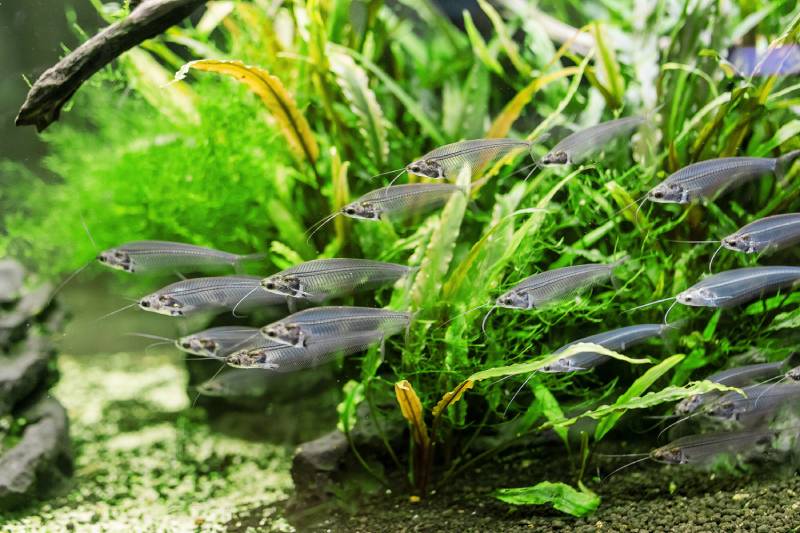
Does This Fish Make a Good Tankmate?
Glass Catfish are incredibly social and peaceful fish with a good reputation in community aquariums. They are compatible with other similarly sized peaceful fish like Neon Tetras, Rasboras, Cherry Barbs, and Honey Gourami. You should only keep Glass Catfish in the same aquarium as other tropical fish that thrive in the same pH range. Tank mates like Goldfish, Oscars, Jack Dempsey, and African Cichlids should be avoided. Those types of fish are usually too large or aggressive to be kept with Glass Catfish.
Keep in mind that as a social species, Glass Catfish need to be kept in groups of five or more. They should never be housed alone as this can be stressful for them.

Care Guide & Tank Set Up
The minimum tank size for a group of five to six Glass Catfish is a 30-gallon long tank. Unfortunately, Glass Catfish are not suitable for small aquaria like vases and bowls.
Let’s take a look below at their tank setup requirements.
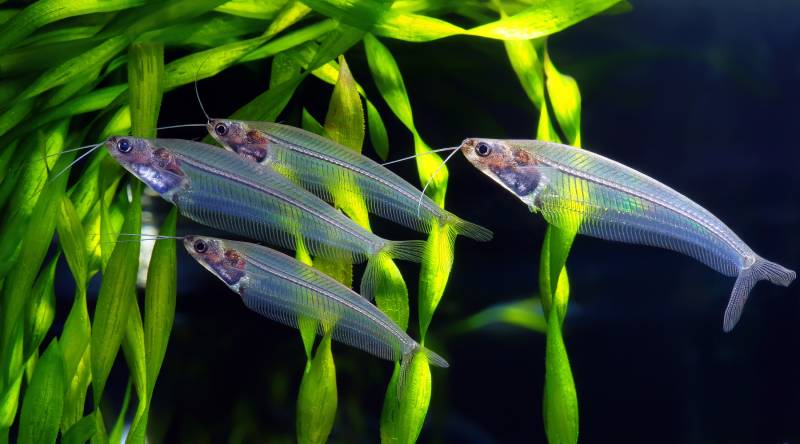
Water Quality, pH & Temperature
Glass Catfish are tropical freshwater fish that need to be kept in mature aquariums. The ammonia and nitrite levels in the water should never fluctuate past zero. The nitrate level is tolerable up until 15 ppm before you need to do a partial water change.
The water pH range should be acidic to slightly neutral with no fluctuations. You can use alder cones or Indian almond leaves in the aquarium to keep the water pH low. Plus, they release tannins into the water which have antifungal properties.
| Temperature: | 75° to 82° Fahrenheit (23° to 28° Celsius) |
| pH: | 6.0 to 7.5 |
| Water hardness: | 18 to 179 ppm |
| Ammonia: | 0 ppm |
| Nitrite: | 0 ppm |
| Nitrate: | Below 15 ppm |
Substrate
A sandy or fine gravel substrate is recommended for Glass Catfish aquariums. The substrate should not alter the water’s chemistry nor release toxins from dyes and chemical residue. Black, brown, tan, and white substrates are preferred over brightly colored ones. There is also a risk of dyed substrates leaching toxins into the water which Glass Catfish are sensitive to.
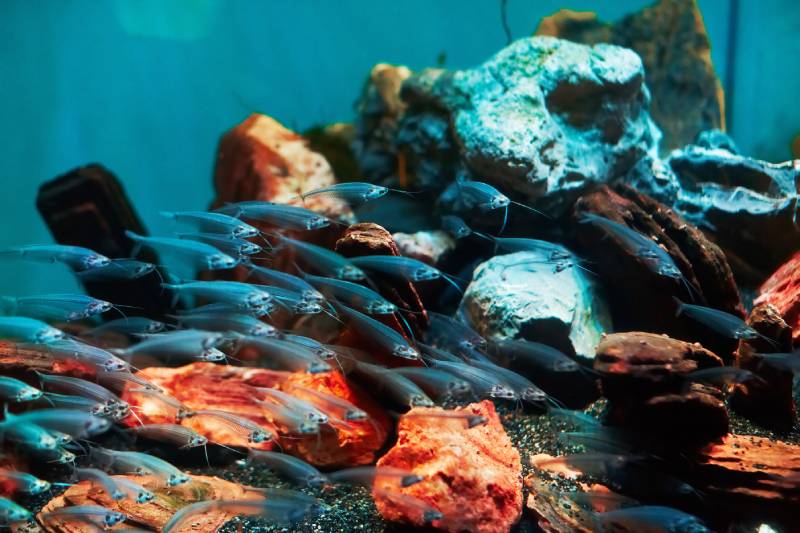
Plants
Glass Catfish thrive in heavily planted aquariums. Live plants offer these fish benefits such as increased oxygenation, natural filtration, and shelter. Glass Catfish feel safe and become more active in planted setups than bare ones. If the aquarium is bare, you might notice that Glass Catfish try to hide behind the filter or in a corner.
Best plants for Glass Catfish:
- Vallisneria
- Anubias
- Hornwort
- Amazon sword
- Java Moss
Lighting
A low to moderately bright aquarium light is suitable for Glass Catfish. Their aquarium does not need very bright lighting which can be stressful for them. The lighting should be kept on for 6 to 10 hours per day and turned off at night. They are active during the day and usually rest at night. It is difficult to see catfish in the dark since their bodies are transparent.
Filtration
Glass Catfish inhabit slow-moving bodies of water with a slow to moderate current. This water movement should be replicated in captivity as Glassfish do not enjoy aquariums with strong water movement. The filter that you use in their aquarium should be strong enough to keep the water moving and clean, without a strong output. Sponge filters, hang-on-back (HOB), and most internal filters are suitable for Glass Catfish aquariums.

Things to Know When Owning a Glass Catfish:
Food & Diet Requirements
Glass Catfish tend to eat a carnivorous diet in the wild consisting of worms, small crustaceans, and zooplankton. They prefer to hunt for live food and work together in groups to find available food.
In captivity, Glass Catfish should eat an omnivorous diet. Their diet should consist of live or freeze-dried foods like tubifex worms, bloodworms, daphnia, and baby brine shrimp. A tropical fish flake or pelleted food should be offered at least once or twice a day. Most Glass Catfish will attempt to eat their tank mate’s food if given the opportunity.
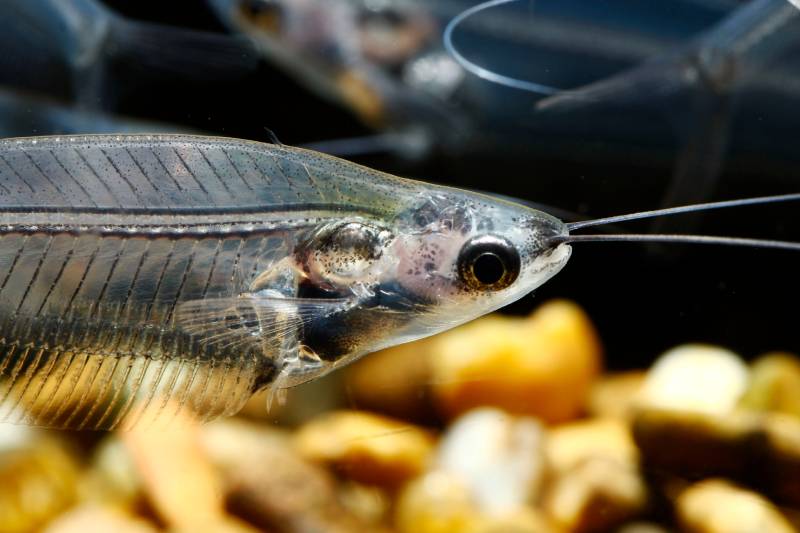
Size & Growth Rate
The size of Glass Catfish varies among the different species. The K. bicirrhis is one of the largest species known to reach a length of 6.5 inches. The K. minor is a smaller species at 2.5 inches long, whereas the K. vitreolus only grows to 3 inches. Glass Catfish have a rapid growth rate within the first 6 months of their lives. Like most fish, Glass Catfish are sexually mature before they reach 12 months old, usually around the 4–6-month mark.
Varieties
There are four main species of Glass Catfish recognized in aquariums that belong in the Kryptopterus genus:
- vitreolus (Glass or Phantom Catfish) – This species is the most popular in aquariums and was misidentified as K. bicirrhis for a while. The Glass or Phantom Catfish have transparent bodies and fins with visible skeletons. They grow to around 2.5 to 3 inches long and have barbels near their mouths that they use to sense their environment. This species is usually what comes to mind when you think of a transparent Glass Catfish.
- bicirrhis (Asian Glass Catfish) – The K. bicirrhis is a large species of Asian Glass Catfish that grows between 5 to 6.5 inches long. They are rare in the aquarium trade industry and do not have the classic transparent body as the other species do. This species has an opaque grey body and visible skeleton, with tendril-like barbels.
- minor (Ghost Catfish) – The smaller species closely related to the K. vitreolus grows between 2 to 2.5 inches long. They are easily recognized by their small size and transparent bodies, although they are rare in aquariums. Some hobbyists believe that true K. minor Glass Catfish are not found in captivity at all.
- piperatus (Glass Catfish) – One of the rarest species infrequently found in aquariums is the K. piperatus. This species has a pale brown body with black spotting. They are not transparent like the K. vitreolus and K. minor and closely resemble the K. macrocephalus or Striped Glass Catfish. It is rare to come across the K. piperatus in captivity.
Due to the variations in the species, it is better to refer to them by their scientific name rather than their common name. Most Glass Catfish share similar common names, such as Phantom, Asian, or Ghost catfish.
Lifespan and Health Conditions
The average lifespan for Glass Catfish is between 5 to 8 years. Part of the reason they are suited for experienced fish keepers is because they are not hardy fish. Glass Catfish are sensitive to changes and their environment and require specific conditions to thrive.
If their proper conditions are not met, Glass Catfish are susceptible to serious health problems caused by poor water quality and stress.
Serious Conditions:
- Ammonia toxicity
- Ich or white spot disease
- Bacterial diseases
- Fungal diseases
- Nitrite toxicity
Unfortunately, many Glass Catfish die before you get a chance to treat them for a specific health problem. They are very delicate fish that are difficult to care for.
Male vs Female
The differences between a male and female Glass Catfish are subtle. Hobbyists usually have a difficult time telling the sexes apart, since their transparent bodies make it confusing. However, male Glass Catfish are believed to be slightly smaller and slenderer than females with triangular heads. Breeding Glass Catfish in captivity is challenging, even expert fishkeepers struggle.

3 Little-Known Facts About Glass Catfish
1. Glass Catfish are transparent because their bodies lack pigment.
2. They do not have scales like most species of catfish.
3. Glass Catfish have a tiny and nearly invisible dorsal fin.
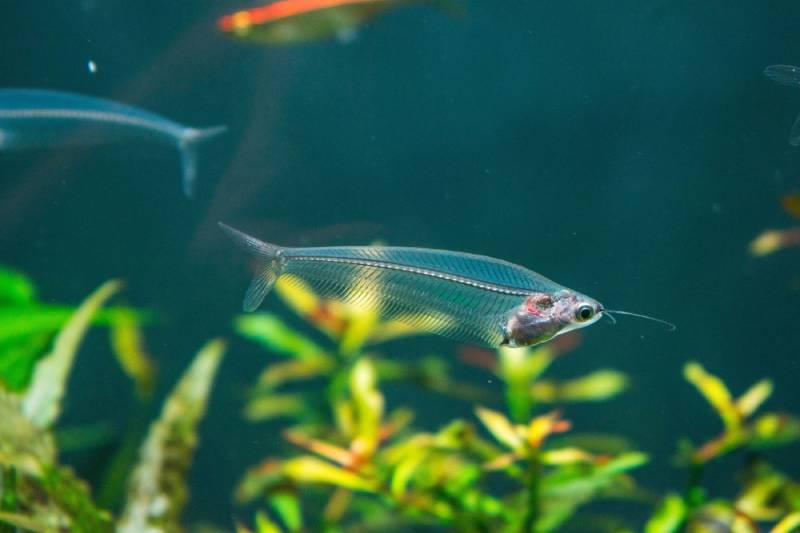

Final Thoughts
If you are an experienced fishkeeper looking for transparent fish to liven up your aquarium, the Glass Catfish is worth considering. They have transparent bodies with visible skeletons, and the most common species (K. vitreolus) rarely exceeds 3 inches in size.
There are three main factors to keep in mind when caring for Glass Catfish—water quality, tank mates, and setup. Water quality is important for Glass Catfish, and they should only be kept in cycled aquariums that have been running for a few months. Furthermore, Glass Catfish thrive in heated, filtered, and planted aquariums over 30 gallons long. While Glass Catfish are compatible with other peaceful fish, they still need to be kept in groups of at least five or six.
Overall, Glass Catfish make unique additions to aquariums with their transparent bodies and schooling behavior.
Featured Image Credit: slowmotiongli, Shutterstock
Tags
What do you think?
Related Articles

New Puppy Checklist: Gear You’ll Need for Your New Dog
Getting a new puppy is really exciting, but before you welcome them home, it’s important to prepare your space for them. Since puppies need a

How Big Do Mini Poodles Get? Vet Reviewed Average Weight & Growth Chart – Dogster
The information is current and up-to-date in accordance with the latest veterinarian research. Learn more » When you buy a Miniature Poodle, you might not

Can Police Dogs Smell Nicotine? Vet Verified Facts & Info – Dogster
The information is current and up-to-date in accordance with the latest veterinarian research. Learn more » While cigarette sales have been declining steadily for decades,

How Old Is 5 in Dog Years? Vet-Approved Guide to Each Size of Dog – Dogster
The information is current and up-to-date in accordance with the latest veterinarian research. Learn more » A common method for calculating a dog’s age is

